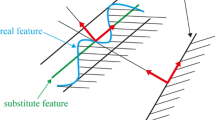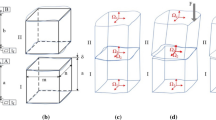Abstract
To control and to manage the geometric deviations along the product life cycle, the first step is to consider, during the design stage, the tolerance specification, the tolerance allocation and the tolerance analysis. Many approaches of the literature for tolerance analysis of rigid assemblies exist, and different commercial computer-aided tolerancing (CAT) software packages were developed with those models. However, there is a growing interest in considering working conditions and operating windows in CAT. As a response to these needs, skin model concept was proposed. The aim of this paper is to connect a point cloud-based discrete geometry framework (i.e. a skin model representation) to the manufacturing processes, in order to bring the CAT simulation tools closer to reality. In this work, the effect of a manufacturing process on solving a stack-up function is investigated throughout circular profiles obtained by a turning process. A case study has been defined and solved using two literature models, the variational model and the vector-loop one, by considering the manufacturing signature. The results have been compared to those obtained by the same models without considering the manufacturing signature. Monte Carlo simulations have been carried out by solving the stack-up functions into Matlab® software, and statistical analyses have been carried out by Minitab® software.
Similar content being viewed by others
References
Schleich B, Anwer N, Mathieu L, Wartzack S (2014) Skin Model Shapes: a new paradigm shift for geometric variations modelling in mechanical engineering. Comput Aid Des 50:1–15
Armillotta A, Semeraro Q (2011) Geometric tolerances-impact on product design, quality inspection and statistical process monitoring. In: Colosimo BM, Senin N (eds) Geometric tolerance specification, 1st revision. Springer, New York
Chase KW, Gao J, Magleby SP (1995) General 2-D tolerance analysis of mechanical assemblies with small kinematic adjustments. J Des Manuf 5(4):263–274
Gao J, Chase KW, Magleby SP (1998) General 3-D tolerance analysis of mechanical assemblies with small kinematic adjustments. IIE Trans 30:367–377
Martino PM, Gabriele GA (1989) Application of variational geometry to the analysis of mechanical tolerance. In: 8th Biennal Conference on Failure Prevention and Reliability. Quebec, Canada
Boyer M, Stewart NF (1991) Modeling spaces for toleranced objects. Int Journal Rob Res 10:470–582
Gupta S, Turner JU (1993) Variational solid modelling for tolerance analysis. IEEE Comput Graph 13:64–74
Desrochers A, Rivière A (1997) A matrix approach to the representation of tolerance zones and clearances. Int J Adv Manuf Technol 13:630–636
Lafond P, Laperrière L (1999) Jacobian-based modeling of dispersions affecting pre-defined functional requirements of mechanical assemblies. In: Proceedings of IEEE International Symposium on Assembly and Task Planning, Porto, Portugal
Laperrière L, Lafond P (1999) Modeling tolerances and dispersions of mechanical assemblies using virtual joints. In: Proceedings of ASME Design Engineering Technical Conferences, Sept. 12–15, Las Vegas, NV
Clément A, Riviére A, Serré P, Valade C (1998) The TTRSs: 13 constraints for dimensioning and tolerancing. In: ElMaraghy HA (ed) Geometric design tolerancing: theories, standards and applications, 1st edn. Chapman and Hall, London, pp 123–131
Rivest L, Fortini C, Morel C (1994) Tolerancing a solid model with a kinematic formulation. Comput Aid Des 26:465–476
Bourdet P, Mathieu L, Lartigue C, Ballu A (1996) The concept of the small displacement torsor in metrology. Advanced Mathematical Tools in Metrology II, World Scientific, Singapore, pp 110–122
Desrochers A, Ghie W, Laperrière L (2003) Application of a unified Jacobian-Torsor model for tolerance analysis. J Comput Inf Sci Eng 3:1–13
Davidson JK, Mujezinovic A, Shah JJ (2002) A new mathematical model for geometric tolerances as applied to round faces. J Mech Des-T ASME 124:609–622
Ameta A, Davidson JK, Shah JJ (2007) Influence of form on frequency distribution for 1-D clearance which is generated from tolerance-maps. In: Proceedings of the Tenth CIRP Conference on Computer Aided Tolerancing, Mar. 21–23, Erlangen, Germany
Anselmetti B, Chavanne R, Yang J-X, Anwer N (2010) Quick GPS: a new CAT system for single-part tolerancing. Comput Aided Des 42(9):768–780
Armillotta A, Semeraro Q (2012) Critical operating conditions for assemblies with parameter-dependent dimensions. In: Proceedings of the 12th CIRP Conference on Computer Aided Tolerancing
Polini W (2012) Taxonomy of models for tolerance analysis in assembling. Int J Prod Res 50(7):2014–2029
Ameta G, Serge S, Giordano M (2011) Comparison of spatial math models for tolerance analysis: tolerance-maps, deviation domain, and TTRS. J Comput Inf Sci Eng 11(2):1–10
Charpentier F, Ballu A, Pailhes J (2012) A scientific point of view of a simple industrial tolerancing process. In: Proceedings of the 12th CIRP Conference on computer aided tolerancing
Dantan JK, Anwer N, Mathieu L (2003) Integrated tolerancing process for conceptual design. CIRP Ann Manuf Technology 52(1):135–138
Moroni G, Pacella M (2008) An approach based on process signature modeling for roundness evaluation of manufactured items. J Comput Inf Sci Eng 8:1–10
Marziale M, Polini W (2010) A new model based on variational solid modelling. In: Proceedings of the ASME 2010 10th Biennial Conference on Engineering Systems Design and Analysis, Instanbul, Turkey, July 12–14
Marziale M, Polini W (2009) A review of two models for tolerance analysis of an assembly: vector loop and matrix. Int J Adv Manuf Tech 43(11-12):1106–1123
Author information
Authors and Affiliations
Corresponding author
Rights and permissions
About this article
Cite this article
Corrado, A., Polini, W. Manufacturing signature in variational and vector-loop models for tolerance analysis of rigid parts. Int J Adv Manuf Technol 88, 2153–2161 (2017). https://doi.org/10.1007/s00170-016-8947-z
Received:
Accepted:
Published:
Issue Date:
DOI: https://doi.org/10.1007/s00170-016-8947-z




